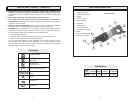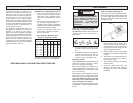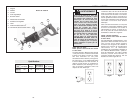
12 13
Selecting the Speed Range
The speed control dial controls the maxi-
mum strokes per minute. The speed will
remain variable to the chosen dial setting
by use of the trigger switch. Refer to the
chart for recommended dial settings.
SUGGESTED
DIAL SETTINGS*
2-3
5
5
1-3
4-5
1-3
1-3
2-3
2-3
MATERIAL
Mild Steel
Wood
Nail-Embedded Wood
Stainless Steel
Drywall
Fiberglass
Plastics
Cast Iron
Non-Ferrous
Metals
* These are only suggested settings;
the actual optimal setting may vary
depending on line voltage, blade
selected and user preference.
Trigger Speed Control Switch
Super Sawzalls
®
are equipped with a trig-
ger speed control switch. It may be oper-
ated at any speed from zero strokes per
minute to full speed. Always start tool be-
fore blade contacts the workpiece. To vary
the speed, simply increase or decrease
the pressure on the trigger. The further
the trigger is pulled, the greater the speed.
To stop the tool, release the trigger and
allow the tool to stop completely before
removing from a partial cut or before lay-
ing the tool down.
General Cutting
For straight or contour cutting from an
edge, line the blade up with your cutting
line. Before the blade contacts the
workpiece, grasp the handle firmly and pull
the trigger. Then guide the tool along your
cutting line. Always hold the shoe flat
against the workpiece to avoid excessive
vibration.
Cutting Metals
Begin cutting at a slow speed, gradually
increasing speed as you cut. When cut-
ting into metals or hard materials that can
not be cut from an edge, drill a starting
hole larger than the widest part of the
blade. Extend blade life by using a solid
blade cutting lubricant.
Plunge Cutting (Figs. 7 & 8)
Your
MILWAUKEE
Sawzall
®
is ideal for
plunge cutting directly into surfaces that
can not be cut from an edge, such as walls
or floors. Orbital action is recommended
for plunge cutting. Plunge cutting may be
done two ways depending on how the
blade is inserted. Column A shows how to
plunge cut with the teeth of the blade fac-
ing down. Column B shows how to plunge
cut with the teeth of the blade facing up.
NOTE: Orbital action will not operate if the
blade is installed upside down.
Do not plunge cut into metal surfaces (see
“Cutting Metals”).
1. Insert the blade into the tool.
If you inserted the blade with the teeth
facing downward, hold the tool as
shown in Column A, resting the edge of
the shoe on the workpiece.
If you inserted the blade with the teeth
facing upward, hold the tool as shown
in Column B, resting the edge of the
shoe on the workpiece as shown.
2. With the blade just above the work-
piece, pull the trigger. Using the edge of
the shoe as a pivot, lower the blade
into the workpiece as shown.
3. As the blade starts cutting, raise the
handle of the tool slowly until the shoe
rests firmly on the workpiece. Then
guide the tool along your cutting line to
acquire the desired cut.
NOTE: To make plunge cutting easier,
use a heavy gauge blade and install
the blade with the teeth facing upward
as shown in Column B.
WARNING!
To reduce the risk of explosion,
electric shock and property dam-
age, always check the work area
for hidden gas pipes, electrical
wires or water pipes when
making blind or plunge cuts.
Cat. No. 6536-21
Fig. 8
Cat. No. 6523-21
Fig. 7
A
B


















